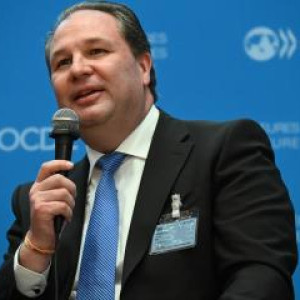IRU President shares model corridor vision at OECD–ITF event

The Middle Corridor can become a global example of efficient and connected trade, IRU underscored during International Transport Forum (ITF) Day at the Organisation for Economic Co-operation and Development (OECD).
In 2024, freight volumes from China to Europe along the Middle Corridor increased by over 80% compared to 2023 - and all signs point to more goods moving through the Middle Corridor in the years to come. As a vital gateway to markets, the Middle Corridor represents opportunities that span far beyond its geographical boundaries.
 IRU President Radu Dinescu
IRU President Radu Dinescu
Speaking at the OECD Paris Headquarters on the panel "Harnessing the potential of the Middle Corridor", IRU President Radu Dinescu said, "Road transport is fundamental to commerce and trade. It is the glue that links all modes of transport together, providing first and last-mile connectivity, and making entire logistics supply chains efficient."
"Our vision is to turn the Middle Corridor into a 'model corridor'," he added. To achieve this, IRU is working with governments along the route based on three guiding principles[1].
- Simplification: Governments should review and streamline existing rules and regulations to eliminate unnecessary administrative burdens.
- Digitalisation: Transport documents should be replaced with data exchange solutions to speed up processes, increase transparency and reduce the number of required documents and the cost of storage.
- Harmonisation: Regulations impacting cross-border commercial road transport should be standardised in a collaborative and coordinated way. This includes the ratification and full implementation of existing UN transport conventions.
Once implemented, this "model corridor" concept[2] could serve as a template for other regions, including the Middle East and South America's Bioceanic Corridor[3].
Addressing operational and institutional challenges, Radu Dinescu identified two key bottlenecks: visa procedures for professional drivers and inefficient border crossing operations. He highlighted that visa issuance is often slow, bureaucratic and opaque, sometimes even discriminatory, as in a case where a female driver's visa was rejected because the authorities could not believe that a woman could drive a truck. Solutions include issuing multi-entry visas, reducing and standardising required documents, introducing e-visas and launching coordinated global action through institutions such as the International Labour Organization.
Radu Dinescu also drew attention to drivers being stranded for days, even weeks, at borders, resulting in economic losses, unnecessary emissions and inhumane conditions. He called for the use of existing UN conventions, such as TIR[4] and e-CMR[5], to streamline border operations. Asked what single action he would prioritise to make the Middle Corridor more dynamic and effective, Radu Dinescu was clear: address inefficiencies at borders.
"These bottlenecks place huge economic burdens on transport operators and national economies," concluded Radu Dinescu. "The tools already exist.
It is time to make the best use of them."
References
- ^ three guiding principles (www.iru.org)
- ^ "model corridor" concept (www.iru.org)
- ^ South America's Bioceanic Corridor (www.iru.org)
- ^ TIR (www.iru.org)
- ^ e-CMR (www.iru.org)
- ^ ITF (www.flickr.com)